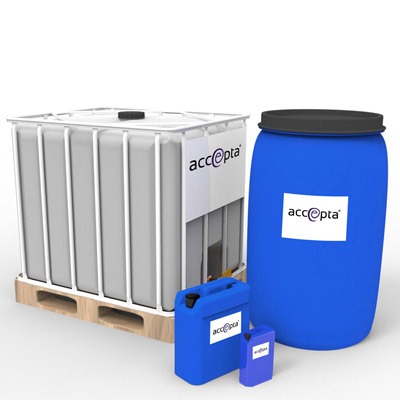CB22 / AT-2344 – Corrosion Inhibitor for Steam Boilers, Condensate Systems & High Pressure Hot Water
- Home
- Water Treatment Chemicals
- Boiler Water Treatment Chemicals
- Oxygen Scavengers
- CB22 / AT-2344 – Corrosion Inhibitor for Steam Boilers, Condensate Systems & High Pressure Hot Water
CB22 also known as AT-2344
Available in 25Kg drums
200Kg and IBC orders are POA
Minimum order quantity is 32 x 25Kg drums
Description Below
Description
CB22 / AT-2344 is a high performance corrosion inhibitor scientifically formulated for use in steam boilers, condensate systems and high pressure hot water systems.
CB22 / AT-2344 is a steam volatile liquid treatment based on Di Ethyl Hydroxylamine used to remove oxygen chemically from feed water, boiler water and condensate in steam generating systems and the recirculating water in high pressure hot water systems.
Additionally, CB22 / AT-2344 passivates iron and copper surfaces, rendering them more resistant to corrosion.
Product Benefits
- High performance corrosion inhibitor
- Passivation of metal surfaces through the formation of magnetite and cuprous oxide films
- Minimisation of iron and copper deposits in the boiler by reducing these metals to their more soluble ferrous and cuprous forms
- Ability to provide corrosion protection to the after-boiler sections of the system
Product Properties
| Appearance: | Clear liquid |
| Odour: | Slight amine |
| pH: | 10 – 11 |
*Full details of the product properties are available in the Safety Data Sheet. See below.
Application & Dosage Information
Steam Boilers
CB22 / AT-2344 should be fed continuously to the deaerator storage section, the condensate or directly to the boiler.
Choice of feed point is dependent upon the specific problem to be corrected. The recommended concentration to be maintained in the feedwater will vary with operating pressure and the particular installation and will be advised by Accepta technical support.
The normal dosage rate for CB22 / AT-2344 is 20ml/m3 of feed water per mg/L of dissolved oxygen and the dosage should be adjusted to give a residual of 0.1 -0.25ppm of DEHA in the feed or boiler water.
High Pressure Hot Water Systems
CB22 / AT-2344 should be dosed at an initial rate of 200ml/m3 and thereafter to maintain a DEHA residual of 5-10ppm.
It is always advisable to carry out a ‘Control Of Substances Hazardous to Health’ (COSHH) assessment before use.
Safety, Storage & Handling
For full details concerning safety precautions, storage and handling procedures for this product please refer to the latest Safety Data Sheet.
To request the latest MSDS for this product please fill out the form below.
Additional information
| Weight | 25 kg |
|---|
Description
CB22 / AT-2344 is a high performance corrosion inhibitor scientifically formulated for use in steam boilers, condensate systems and high pressure hot water systems.
CB22 / AT-2344 is a steam volatile liquid treatment based on Di Ethyl Hydroxylamine used to remove oxygen chemically from feed water, boiler water and condensate in steam generating systems and the recirculating water in high pressure hot water systems.
Additionally, CB22 / AT-2344 passivates iron and copper surfaces, rendering them more resistant to corrosion.
Product Benefits
- High performance corrosion inhibitor
- Passivation of metal surfaces through the formation of magnetite and cuprous oxide films
- Minimisation of iron and copper deposits in the boiler by reducing these metals to their more soluble ferrous and cuprous forms
- Ability to provide corrosion protection to the after-boiler sections of the system
Product Properties
| Appearance: | Clear liquid |
| Odour: | Slight amine |
| pH: | 10 – 11 |
*Full details of the product properties are available in the Safety Data Sheet. See below.
Application & Dosage Information
Steam Boilers
CB22 / AT-2344 should be fed continuously to the deaerator storage section, the condensate or directly to the boiler.
Choice of feed point is dependent upon the specific problem to be corrected. The recommended concentration to be maintained in the feedwater will vary with operating pressure and the particular installation and will be advised by Accepta technical support.
The normal dosage rate for CB22 / AT-2344 is 20ml/m3 of feed water per mg/L of dissolved oxygen and the dosage should be adjusted to give a residual of 0.1 -0.25ppm of DEHA in the feed or boiler water.
High Pressure Hot Water Systems
CB22 / AT-2344 should be dosed at an initial rate of 200ml/m3 and thereafter to maintain a DEHA residual of 5-10ppm.
It is always advisable to carry out a ‘Control Of Substances Hazardous to Health’ (COSHH) assessment before use.
Safety, Storage & Handling
For full details concerning safety precautions, storage and handling procedures for this product please refer to the latest Safety Data Sheet.
To request the latest MSDS for this product please fill out the form below.
Additional information
| Weight | 25 kg |
|---|
Data Sheets & enquires
To request the safety or technical data sheets on this product or simply enquire further about chemical supply please fill out this contact form.
Contact us
Please complete this form and we will be in touch
